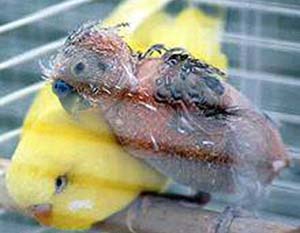
Psittacine Beak and Feather Disease (PBFD) has been recognised as a most significant disease of psittacine birds worldwide.
It is not a new disease. The earliest record of an outbreak of PBFD occurred in wild red-rumped parrots in the Adelaide hills of Australia in 1888. Since then PBFD has been confirmed in wild galahs, sulphur-crested cockatoos, corellas, rainbow lorikeets, orange-bellied parrots, rosellas, ringneck parrots, leadbetter cockatoos, gang gang cockatoos, king parrots, swift parrots, budgerigars, and many other species.
PB&FD was rarely seen in the exhibition budgerigar community in the past. During recent years however, as a result of photos posted on the Internet and on budgie groups in Facebook, it became obvious that PB&FD was widespread, in fact now a major concern in many countries, especially those where budgerigars are imported to supply local demand.
The problem of spreading the disease is compounded by two issues.
First affected adult budgerigars carrying the disease appear totally normal in most cases, while occassionally they may be missing a flight or two or even a tail. So they cannot be identified until the owner breeds with them and sees signs of PB&FD in the youngsters.
Secondly, because so few breeders have seen affected birds, or had any experience with PB&FD, it is frequently misdiagosed as severe French Moult which is a totally unrelated virus and somewhat easy to control.
French Moult or PB&FD?....
FM is a virus all budgies carry that is triggered by stress. Anything from lack of nutrition during weaning, change in food, housing, illness or introduction of new birds can cause enough stress to cause an outbreak.
A common cause is the introduction of new stock. The FM virus is aviary specific (ie varies from stud to stud), and when new birds are introduced it takes approximately 3-4 months for the virus to mutate and form a new strain specific to that stud. If any birds are breeding in the aviary during this period the chances of a FM outbreak are greatly increased.
Youngsters affected by FM lose their flights and/or tail feathers a week or two AFTER leaving the nest.
These feathers usually regrow within 6-8 weeks and the budgie will have a normal appearance.
Because the virus has then mutated to a new strain these FM affected youngsters will breed when they are old enough, and in most cases none of the resulting young will have FM.
Best method to control an FM outbreak is to break up all breeding pairs and rest them in the flight for 3-4 months, and resist the temptation to introduce new birds on a regular basis.
PSITTACINE BEAK & FEATHER DISEASE -
Chicks start shedding their feathers while they are still in the nest, often looking like French Moulters by the time they emerge.
They continue to drop feathers on other parts of the body and wings. These feathers do not regrow but are often replaced with a thich fuzzy down.
In severe cases the bird will eventually end up naked except for a few feathers on the head.
Youngsters affected with PBFD will frequently look like French Moulters when they leave the nest.
The shedding continues on other parts of the body and wings. Lost feathers are replaced by a thick fuzzy down.
HOW IT WORKS:
PB&FD is not transfered from adult bird to adult bird. The adult "carrier" infects chicks with the disease as they start to feather up. The disease than spreads from chick to chick in the nest, or later in a baby/nursery holding cage.
The unsuspecting breeder may also transfer the disease from nest to nest if he does not disinfect his hands when going from one nest to another.
THE BAD NEWS -
There is no cure for PB&FD... The only remedy if you are unfortunate enough to experience an outbreak, is to dispose of all affected chicks along with the carrier adults.
DO NOT sell or give these birds away to another breeder. You will only pass the disease on to their aviary too.
It is VERY difficult to totally eradicate the disease once birds in an aviary have been affected and safety precautions should be taken for several years following any outbreak.
Despite the claims of some commercial PBFD/Polyoma tests being used by some veterinarians, trial tests by university avian research facilities have concluded they are very, very unreliable.
Whilst many attempts have been made to produce a vaccine or medication to combat PB&FD, to date only one has proved successful. But unfortunately the vaccine has not come to market because of the high cost to get it approved by government agencies.
Research continues, and diagnostic techniques are improving, but this disease is well established in both wild and captive populations of psittacine birds, and will continue to give problems to aviculturists and avian veterinarians for many years to come.
